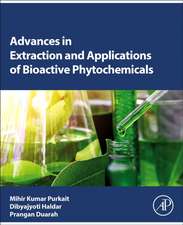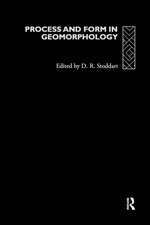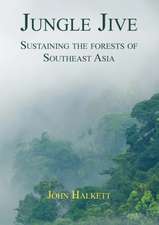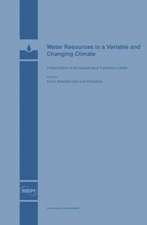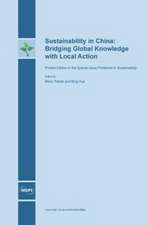Recovery of Bioactives from Food Wastes
Autor Mihir Kumar Purkait, Prangan Duarah, Pranjal Pratim Dasen Limba Engleză Paperback – 9 oct 2024
Features:
- Presents critical discussion on various advancement in various extraction processes including future trends.
- Provides elaborative description of food waste sources and challenges associated with it.
- Highlights potential of bioactive compounds in various industries.
- Quantitatively discusses existing as well as new technologies/methodologies.
- Includes a separate chapter on pertinent policies of various countries.
| Toate formatele și edițiile | Preț | Express |
|---|---|---|
| Paperback (1) | 318.40 lei 43-57 zile | |
| CRC Press – 9 oct 2024 | 318.40 lei 43-57 zile | |
| Hardback (1) | 897.38 lei 43-57 zile | |
| CRC Press – 13 apr 2023 | 897.38 lei 43-57 zile |
Preț: 318.40 lei
Preț vechi: 363.93 lei
-13% Nou
Puncte Express: 478
Preț estimativ în valută:
60.95€ • 66.22$ • 51.23£
60.95€ • 66.22$ • 51.23£
Carte tipărită la comandă
Livrare economică 21 aprilie-05 mai
Preluare comenzi: 021 569.72.76
Specificații
ISBN-13: 9781032325262
ISBN-10: 1032325267
Pagini: 234
Ilustrații: 60
Dimensiuni: 178 x 254 mm
Greutate: 0.43 kg
Ediția:1
Editura: CRC Press
Colecția CRC Press
Locul publicării:Boca Raton, United States
ISBN-10: 1032325267
Pagini: 234
Ilustrații: 60
Dimensiuni: 178 x 254 mm
Greutate: 0.43 kg
Ediția:1
Editura: CRC Press
Colecția CRC Press
Locul publicării:Boca Raton, United States
Public țintă
AcademicCuprins
1. Food waste as a potential source of bioactive compounds. 1.1. Overview of food waste. 1.2. Environmental effects and management approach. 1.3. Valorization of food waste in various applications. 1.4. Conclusions. References. 2. Current status and future trends of various food industry waste processing for synthesis of bioactive compounds. 2.1. Introduction. 2.2. Bioactive compounds in various food industry waste. 2.3. Commercial aspects. 2.4. Challenges and future perspective. 2.5. Conclusions. References. 3. Technological advancement in the extraction of bioactive compounds from food industry waste. 3.1. Introduction. 3.2. Conventional methods for the extraction of bioactive compounds. 3.3. Progress in the extraction of bioactive compounds. 3.4. Commercial utilization of the extraction process. 3.5. Conclusions. References. 4. Recovery of bioactive compounds from fruit and vegetable peel. 4.1. Introduction. 4.2. Recovery of bioactive compounds from fruit peel. 4.4. Conclusions. References. 5. Utilization of seeds for the synthesis of bioactive compounds. 5.1. Introduction. 5.2. Characteristics and nutrient loss in fruit and vegetable waste. 5.3. Bioactive compounds in fruit and vegetable seeds. 5.4. Conclusions. References. 6. Sustainable green processing of various fruit and vegetable pomace from the food industry for the synthesis of bioactive compounds 6.1. Introduction. 6.2. Synthesis of bioactive compounds form fruit and vegetable pomace. 6.3. Challenges and future perspectives. 6.4. Conclusions. References. 7. Extraction of bioactive compounds from marine by-products. 7.1. Introduction. 7.2. Bioactive element available in Marnie by-products. 7.3. Technological advancement in the extraction process. 7.4. Commercial aspects. 7.5. Challenges and future perspectives. 7.6. Conclusions. References. 8. Extraction of bioactive compounds from tea, coffee and wine processing waste. 8.1. Introduction. 8.2. Present status of tea, coffee and wine production. 8.3. Extraction of bioactive compounds. 8.4. Conclusions.References. 9. Commercial aspects of bioactive compounds extracted from food waste. 9.1. Introduction. 9.2. Utilization of bioactive compounds in various industries. 9.3. Challenges and future trends. 9.4. Conclusion. References. 10. Food waste management and valorization policies of various countries. 10.1. Introduction. 10.2. International goals and agreements. 10.3. Policies of various countries. 10.4. Major challenges. 10.5. Conclusions. References.
Descriere
This book describes varied aspects involved in dealing with extraction and utilization of bioactive compounds from the food industry waste. It covers global scenario of food waste generation and potential of food waste on various industries, extraction techniques, and application of industrial food waste derived bioactive compounds.








